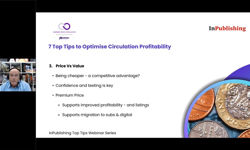
There are three main kinds of data which can be used to provide actionable insight into retention. The first publishers often have in excess: historic data, demonstrating how customer behaviour and changes in strategy have influenced the file previously.
Historic data provides a treasure trove of insights into behaviour: for example, we know that over 40,000 of The Week’s subscribers received their first copy over ten years ago. We know 400 subscribers from the cohort who received their first copy of the magazine in 1995, are still active – the whole cohort has delivered nearly £2million in revenue. These metrics are the foundation for growth planning and forecasting, allowing The Week to base future strategies on previous experience and predict long term behaviour.
The second set of data is demographic – who customers are, what their relationship to the magazine is, and how they want to consume it.
As publishers, it’s easy to fixate on the perfect price point. From a customer point of view, it’s more about value versus price; and value is defined by their relationship with and engagement as a reader of the magazine. Consumers relate to price and value differently.
This insight is core to the success of both The Week and The Week Junior. On the former, the rituals readers have when indulging in the magazine – in the bath on Friday night, over breakfast on Saturday morning, shows how much the magazine is an integral part of their lives. What it delivers – a balanced approach to the week’s news – is its value to them, above and beyond the price they’re paying. Their loyalty to the brand is everything, and any communications to them should relate to this loyalty.
On the latter, the value to the payer (mostly a parent) is watching their child develop curiosity and learn about the world, being able to engage with and know about world news in an accessible way. Investment in their child’s future – not to mention watching a child reading quietly and intently – is what the payer values about the magazine. These insights are essential to the tone of any communications to either audience.
The final set of data isn’t one publishers have immediately to hand – results from testing. Based on both historic and demographic data, implementing tests that provide insights into behaviour are the one absolute way to determine how well a yield strategy will function. Using existing data to model out future plans must be backed up with a test as even unsuccessful tests help publishers learn about subscriber behaviour.
Strategic yield planning is most successfully done in partnership with forecast modelling: Lifetime Value (LTV) is the key overall metric. Publishers need to understand which levers influence profitability so they can plan – and deliver – yield growth.
There are four key factors influencing subscriber motivation: tenure (how long a subscriber has been subscribing), payment method, payment term (particularly on recurring renewals) and price paid.
Modelling subscriber behaviour – either from a full file point of view for investment, or creating a hierarchy of acquisition channels is powerful. It can identify how quickly a subscription delivers profit, factoring in cost per acquisition (CPA), fulfilment costs, renewal metrics, pricing and subscription terms. Driving profitability and defining the point at which investment must deliver net profit allows the publisher to prioritise channels, and justify investment with confident forecasting. Deciding new orders need to be profitable within, say, two years, allows the publisher to quickly identify channels to back, and to retire.
Higher CPA channels often fall out of favour in a drive for quick profitability – they have a higher cost to deliver a paid subscriber when compared to cheaper acquisitions. However, if the renewal metrics for a subscriber acquired through higher CPAs mean long term sustainability, are those ‘up front’ CPA metrics sufficient on their own to facilitate profitable decisions?
Direct mail might cost several times more than, say, an affiliate order, but if only 10% of affiliate trials actually remain on the file one year later, in comparison to 70% of subscribers driven through direct mail, which is worth your marketing team spending its time on?
Seeing the entire file through its LTV is crucial for driving yield – any tests can be modelled out to show the impact of price changes, churn or loyalty on future years. An LTV model is a crucial weapon in the publisher’s arsenal when engaging with yield and investment.
Over 40,000 of The Week’s subscribers received their first copy over ten years ago.
The maths of ongoing loyalty – real examples
On The Week, new orders are acquired on a quarterly direct debit. With an annual price over £125, quarterly rates of £35.99 are a far more attractive price for an offer to an audience which isn’t yet loyal. A quarterly payment, though, drives churn at four key points during the year as each payment is taken.
If 90% of quarterly automatically recurring subscribers (mostly on DD, though continuous credit card and other new recurring payment methods are just as relevant) renew at each payment, only 65% will be left at the end of the year. If they could be acquired on biannual (six monthly) terms, at the same renewal rate, 81% would still remain – but this pricing depresses acquisition volumes. It’s a balance of yield vs volume. It’s not easy to drive yield at point of acquisition as price is so much more influential in customer decisions – volume often can’t be driven at higher yields.
At renewal, though, the approach can be very different. In 2016 on The Week, 80% of direct debits were on quarterly payment schedules. Many had been on the file longer than five years with renewal rates in excess of 95%. There’s little space to improve on such spectacular renewals. That’s where compound annualised churn metrics come into play. If there were only two renewal points during the year, renewals could drop 5% and a higher number of subscribers would still remain on the file at year end.
Consumers relate to price and value differently.
Price increases driven by data insight
LTV models can identify high yielding strategies, to take into the real world. It’s essential to test price both on acquisition and renewal on small segments before roll-out: more radical tests need to be proven before roll-out to protect the file’s profitability.
All the tests implemented on The Week were based on cohorts defined by tenure and demographic insights. Prices were stepped up relative to what we knew about subscriber loyalty and historical behaviour. Tests where long term subscribers were given a price increase, and simultaneously had their term extended to six monthly were revolutionary. The behavioural insight leading to this strategy was that these subscribers had been on the file for so long, their ‘habit’ would be entrenched.
‘Triallists’ are new subscribers, about to step up to full price, and demonstrate high churn. Stepped up to a quarterly price, they’re still building habit, so low price points are crucial. These customers won’t receive further price step-ups until they’ve been subscribing to and indulging in ‘The Week habit’ for another full calendar year.
‘Inbetweeners’ have been on the file between one and two years. Prices are increased, but kept on quarterly terms. Habit is forming, but not so much that the magazine’s value is unquestioned.
‘Adopters’ have been subscribing for 3-5 years. These readers we extend to biannual (six monthly) terms, incentivised by a discount (another element tested in detail). The impact of this significant change is balanced out by the decrease in churn in moving to two payments per year rather than four.
Finally, our ‘Loyalists’ have been on the file for more than five years. Most have already been stepped up to biannual automatic renewal terms. Our insight, borne out by research into these subscribers, shows they treat The Week as a trusted friend. Unsurprisingly this group is the most elastic – tests showed they could withstand higher increases. Within reason, of course, – we don’t want to offend those people with whom we have the closest relationship.
Tests to identify the perfect incentive for customers going through both a price and term increase reinforced that the product’s value was essential to customer perception.
The more ‘special’ the discount or incentive was, the better it was received. A 5% discount, framed as a “loyalty discount”, was most successful. Best of all, giving subscribers an ongoing 5% discount, but reducing payment-driven churn to two points a year with biannual recurring terms, increased LTV over three years by 12%.
Five top tips for driving yield through data insights:
- Get to grips with historic data and build LTV models that can be used to predict future behaviour.
- Use LTV to prioritise acquisition investment: drive volume of subscribers with a propensity to be loyal with ROI within your chosen timeframe.
- Use the key levers – tenure, payment method, payment term and price paid to model out the optimum balance of volume versus profit.
- Get to know your subscribers and frame increases in price through insights you have into their engagement and loyalty.
- Test and validate your theories and roll-out the most effective tests.
The science of understanding your existing data is essential to driving yield growth – it isn’t as simple as simply increasing your price and accepting the resulting impact on your circulation.
Understanding compound churn metrics drives profitability. An LTV model helps to prioritise spend to deliver ROI through customer-focused and insightful yield management. Driving change, based on a clear understanding of longevity, cohort, existing term and price paid combined with the data insights generated by your acquisition and retention marketing, is essential for yield growth whilst maintaining subscriber relationships and delivering subscriber value.
An LTV model is a crucial weapon in the publisher’s arsenal when engaging with yield and investment.
This article was first published in InPublishing magazine. If you would like to be added to the free mailing list, please register here.












